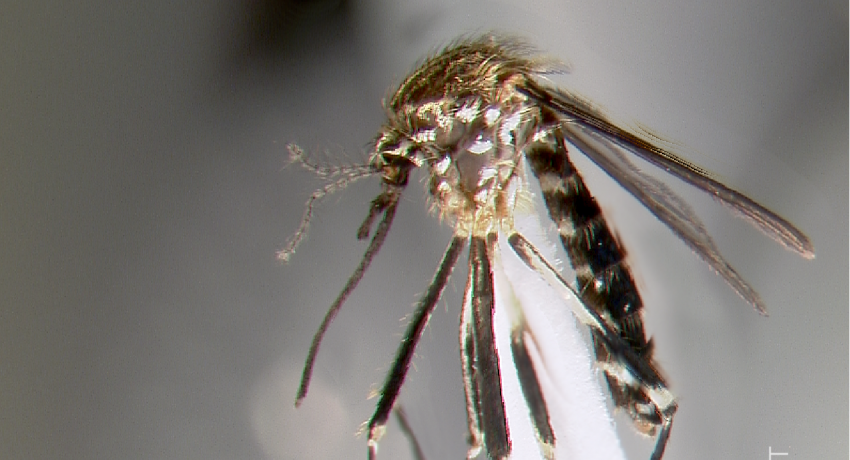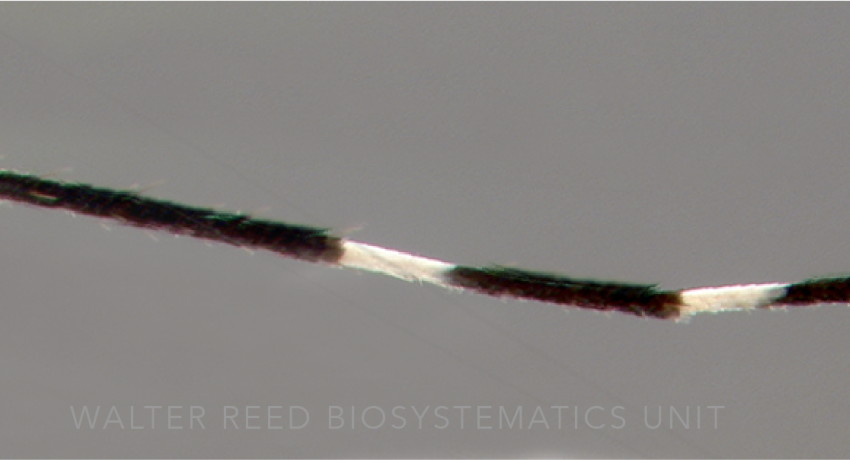ORIENTAL REGION
[Europe & United States invasive]
Etymology: Japan
Aedes japonicus adults have a distinctive bronze lyre-shape pattern on the scutum. The nominotypical form is sometimes referred to as Ae. japonicus japonicus to differentiate it from its three valid and morphologically distinct subspecies—Ae. japonicus shintienensis Tsai and Lien described from Taiwan, and Ae. japonicus amamiensis Tanaka, Mizusawa & Saugstad and Ae. japonicus yaeyamensis Tanaka, Mizusawa & Saugstad, both described from different parts of the Ryukus Islands, Japan. Recent molecular studies indicate that these subspecies will soon be elevated to species in their own right.
Aedes japonicus japonicus is considered highly invasive, expanding from its native range of Korea and Japan through a series of sequential invasions starting in the United States (Pennsylvania) in 1998. By 2012, it was established in other regions of the United States (Hawaii, Washington, Oregon, and the eastern states), in Canada (Quebec and Ontario) and has become established in much of central Europe (Austria, Belgium, Germany, Slovenia, Switzerland), and has been intercepted and eradicated in France and New Zealand. The similarly invasive Southeast Asian species Ae. koreicus (Edwards) is so closely related that it is often considered a sibling species to Ae. japonicus.
Type locality: Tokyo, [Honshu], Japan
Type depository: Natural History Museum, London, England, United Kingdom (NHMUK)
DIAGNOSTIC CHARACTERS (Click photos to view; mouse over and click large photo to zoom in.)
ADULT (illustrated): Head: Proboscis dark-scaled, without pale band. Thorax: Scutellar (lobes with long, narrow scales; scutum with golden stripes; distinctive lyre-shaped stripes, and two submedian and a median stripe. Legs: Ta-III1–3 with broad pale basal bands; Ta-III4 all dark or with a few pale scales at base; Ta-III5 all dark.
LARVA (not illustrated): Head: Setae 5,6-C multi-branched and inserted near anterior edge of head, 5-C medial to 6-C. Terminal segments: Seta 1-S inserted within the pecten; one or more distal pecten spines widely spaced; saddle incomplete; seta 1-X close to posterior margin of saddle; seta 4-X inserted on grid; precratal setae absent.
TAXONOMIC KEYS
Tanaka et al. 1979
Tanaka 2002a
Darsie & Ward 2005
Harrison et al. 2016
Exemplar DNA sequences
Ae. japonicus COI: JX259639–46, KF211480–505, KF874592–303, KM457579–98.
BIONOMICS
Immatures
Female Aedes japonicus japonicus oviposit on the walls of shaded container habitats containing fresh water rich in organic matter. Preferred habitats are stone or cement containers with moderate levels of organic matter and turbid / colored waters, though immatures have been collected in tree holes, bamboo, artificial containers, and in ground pools. Larval development occurs at temperatures above 10°C.
Adults
In their natural environment, Ae. japonicus inhabit forested areas, and are active during the day. Females bite humans and large mammals, especially horses, but readily feed on mice and chicks in the laboratory. The species overwinters as eggs in cooler portions of its range and as larvae in warmer areas. Its successful invasion into Europe and North America has been credited to its larval habitat plasticity, and adult cold tolerance that allows expanded seasonal activity in temperate climates.
DISTRIBUTION NOTES
Austria, Belgium, Canada, Croatia, France, Germany, Hungary, Israel, Italy, Japan, Liechtenstein, Luxembourg, Netherlands, Panama, People's Republic of China, Romania, Russia, Slovenia, South Korea, Spain, Switzerland, Taiwan, Turkey, United States (continental, Hawaiʻi).

WRBU VECTOR HAZARD REPORTS
VHR: Medically Important Mosquitoes of EUCOM
View other WRBU Vector Hazard Reports
Available GIS Models:
None
IMPORTANT REFERENCES (full citations below)
Theobald 1901a: 385 (F; as Culex)
Knight 1948 (1947)c, 631 (M, F, L*)
LaCasse & Yamaguti 1950: 151 (M*, F*, L*; bionomics, distribution, taxonomy)
Hara 1957: 61 (F*)
Mohrig 1967 (F*)
Knight 1968: 15 (M*, F, L*)
Miyagi 1971: 142 (A, L; distribution)
Matsuo et al. 1972: 360 (E*)
Moriya et al. 1973 (E*)
Tanaka et al. 1975c: Tanaka et al. 1975c: 220 (taxonomy, distribution)
Tanaka et al. 1979: 308 (M*, F*, P*, L*; keys, taxonomy, review, bionomics)
Peyton et al. 1999: 238 (F*, L*; distribution)
Fonseca et al. 2001 (molecular taxonomy; sensu lato)
Tanaka 2002a: 64 (P*; taxonomy, key)
Schaffner et al. 2003 (distribution; France)
Darsie & Ward 2005 (F*, L*; keys, distribution)
Haddow et al. 2009 (E*)
Harrison et al. 2016 (F*, L*; keys, distribution, taxonomy)
Robert et al. 2019 (distribution, Euro-Mediterranean)
Eritja et al. 2020 (distribution; Spain)
CURRENT SYNONYMS
syn. eucleptes Dyar
1921i: 147 (M, F). Type locality: Canton (Christian Coll), China [People's Republic of China] (USNM). References: Edwards 1922b: 465 (synonymy with japonicus); Tanaka et al. 1979: 317 (M*, F*, L; type info.).
ssp. shintienensis Tsai & Lien
1950: 177 (M*, F*, P*, L*; as Aedes). Type locality: Chuchih, Shintien (Chen), Taipeh (Hsien), Formosa [Taiwan, Republic of China] (?NTU). Distribution: Taiwan. References: Lien 1962: 623 (to ssp.); Miyagi 1971: 142 (syn.); Tanaka et al. 1979: 317 (M*, F*; from syn. with japonicus); Tanaka 2002a: 72 (P*; tax., key). Etymology: Shintien, Taiwan. Informal name: Shintien Taiwanese Pointy Mosquito.
syn. tokushimaensis Tanimura
1952: 176 (A). Type locality: Tokshima, Shikoku, Japan (ND). References: Sasa & Kamimura 1971: 16 (syn.).
syn. bisanensis Suzuki, Tanimura, Miyagawa & Murata
1953: 8 (A). Type locality: Tokushima, Shikoku, Japan (ND). References: Sasa & Kamimura 1971: 16 (syn.).
ssp. amamiensis Tanaka, Mizusawa & Saugstad
1979: 312(M, F*, L; as Aedes). Type locality: Mt. Yuwan, Amami Oshima, Ryukyus, Japan (NMST). Distribution: Japan. References: Tanaka 2002a: 67 (P*; tax., key). Etymology: Amami, Tanzania. Informal name: Amami Japanese Pointy Mosquito.
ssp. yaeyamensis Tanaka, Mizusawa & Saugstad
1979: 313 (M, F*, L; as Aedes). Type locality: Nr. Yonehara, Ishigaki Island, Ryukyus, Japan (NMST). Distribution: Japan. References: Tanaka 2002a: 70 (P*; tax., key). Etymology: Yaeyama Islands, Japan. Informal name: Yaeyama Japanese Pointy Mosquito.
CURRENT SUBSPECIES
None
CITED REFERENCES
Darsie, R.F., Jr., & Ward, R.A. (2005). Identification and geographical distribution of the mosquitoes of North America, north of Mexico. Gainesville, FL: University Press of Florida.
Dyar, H.G. (1921i). Two new mosquitoes from China (Diptera, Culicidae). Insecutor Inscitiae Menstruus, 9, 147–148.
Eritja, R., Ruiz-Arrondo, I., Delacour-Estrella, S., Schaffner, F., Álvarez-Chachero, J., Bengoa, M., Puig, M., Melero-Alcíbar, R., Oltra, A. & Bartumeus, F. (2019). First detection of Aedes japonicus in Spain: An unexpected finding triggered by citizen science. Parasites and Vectors, 12(1). https://doi.org/10.1186/s13071-019-3317-y
Fonseca, D.M., Campbell, S., Crans, W.J., Mogi, M., Miyagi, I., Toma, T., …Wilkerson, R.C. (2001). Aedes (Finlaya) japonicus (Diptera: Culicidae), a newly recognized mosquito in the United States: Analysis of genetic variation in the United States and putative source populations. Journal of Medical Entomology, 38(2), 135–146.
Haddow, A.D., Moulton, J.K., Gerhardt, R.R., McCuiston, L.J., & Jones, C.J. (2009). Description of the egg of Ochlerotatus japonicus japonicus (Diptera: Culicidae) using variable pressure scanning electron microscopy. Journal of Medical Entomology, 46(1), 9–14.
Hara, J. (1957). Studies on the female terminalia of Japanese mosquitoes. Japanese Journal of Experimental Medicine, 27, 45–91.
Harrison, B.A., Byrd, B.D., Sither, C.B., & Whitt, P.B. (2016). The mosquitoes of the Mid-Atlantic Region: an identification guide (Vol. 1). Madison Heights, MI: Publishing XPress.
Horváth, C., Cazan, C. D., & Mihalca, A. D. (2021). Emergence of the invasive Asian bush mosquito, Aedes (Finlaya) japonicus japonicus, in an urban area, Romania. Parasites & Vectors, 14(1), 1-7.
Knight, K.L. (1968). Contributions to the mosquito fauna of Southeast Asia. IV. Species of the subgroup chrysolineatus of group D, genus Aedes, subgenus Finlaya Theobald. Contributions of the American Entomological Institute, 2(5), 1–45.
Knight, K.L., & Chamberlain, R.W. (1948). A new nomenclature for the chaetotaxy of the mosquito pupa, based on a comparative study of the genera (Diptera: Culicidae). Proceedings of the Helminthological Society of Washington, 15, 1–18.
La Casse, W.J., & Yamaguti, S. (1950). Mosquito fauna of Japan and Korea (with 95 original plates): Office of the Sugeon, Headquarters 8th Army, APO 343.
Matsuo, K., Yoshida, Y., & Kunou, I. (1972). The scanning electron microscopy of mosquitoes (Diptera: Culicidae). I. The egg surfaces of five species of Aedes and Armigeres subalbatus. Journal of the Kyoto Prefectural University of Medicine, 81, 358–363.
Miyagi, I. (1971). Notes on the Aedes (Finlaya) chrysolineatus subgroup in Japan and Korea (Diptera: Culicidae). Tropical Medicine, 13(3), 141–151.
Mohrig, W. (1967). Die taxonomische Bedeutung der Struktur weiblicher Genitalien im Culiciden- Tribus Aedini. Angewandte Parasitologie, 8, 67–100.
Moriya, K., Yabe, T., & Harada, F. (1973). Chorionic markings of some aedine mosquitoes in Japan. 1. Preliminary observations by a scanning electron microscope and a reflected lighting microscope. Japanese Japanese Journal of Sanitary Zoology, 24(1), 47–55.
Peyton, E.L., S.R., Candeletti, T.M., Romanowski, R. M., & Crans, W.J. (1999). Aedes (Finlaya) japonicus japonicus (Theobald), a new introduction into the United States. Journal of the American Mosquito Control Association, 15(2), 238–241.
Robert, V., Günay, F., Le Goff, G., Boussès, P., Sulesco, T., Khalin, A., Medlock, J.M., Kampen, H., Petrić, D. & F. Schaffner. (2019). Distribution chart for Euro-Mediterranean mosquitoes (western Palaearctic region). Journal of the European Mosquito Control Association, 37, 1–28.
Sasa, M., & Kamimura, K. (1971). Index and consideration on taxonomy of the Japanese mosquitoes (In Japanese). In M. Sasa (Ed.), Progress in medical zoology (Vol. I, pp. 1–47). Tokyo: Gakujutsusho Shuppankai.
Schaffner, F. (2003). Mosquitoes in used tyres in Europe: species list and larval key. European Mosquito Bulletin, 7–12.
Suzuki,Y., Tanimura, S., Miyagawa, M. & Murata, S. (1953).Species of mosquitoes collected in Tokushima City. III [in Japanese]. Igaku to seibutsugaku [Medicine and Biology], 28, 8–10.
Tanaka, K. (2002a). Studies on the pupal mosquitoes of Japan. (5) Four subspecies of Aedes (Finlaya) japonicus Theobald, including subsp. shintienensis from Taiwan (Diptera, Culicidae). Japanese Journal of Systematic Entomology, 8(1), 63–77.
Tanaka, K., Mizusawa, K., & Saugstad, E.S. (1979). A revision of the adult and larval mosquitoes of Japan (including the Ryukyu Archipelago and Ogasawara Islands) and Korea (Diptera: Culicidae). Contributions of the American Entomological Institute, 16, 1–987.
Tanaka, K., Saugstad, E.S., & Mizusawa, K. (1975c). Mosquitoes of the Ryukyu Archipelago (Diptera: Culicidae). Mosquito Systematics, 7(3), 207–233.
Tanimura, S. (1952). On the variation of the number of white bands of legs of Aedes japonicus Theobald collected in Tokushima City. likken Seibutsu Gakuho, 2, 173–178.
Theobald, F.V. (1901a). A monograph of the Culicidae or mosquitoes (Vol. 1). London: British Museum (Natural History). [424pp]
Tsai, C., & Lien, J.C. (1950). A new species of Aedes (Finlaya) found in Taiwan. Journal of the Formosan Medical Association, 49, 177–183.
CITE THIS PAGE
Walter Reed Biosystematics Unit (Year). Aedes japonicus species page. Walter Reed Biosystematics Unit Website, http://wrbu.si.edu/vectorspecies/mosquitoes/japonicus, accessed on [date (e.g. 03 February 2020) when you last viewed the site].










































































































































































